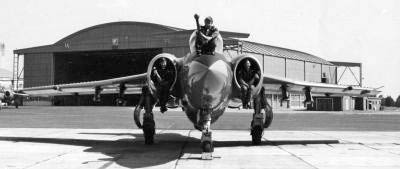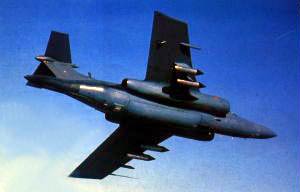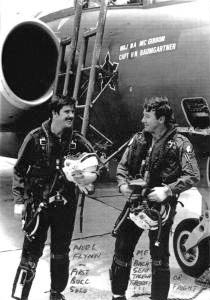Blackburn Buccaneer - Memories
The following article was kindly supplied by Major (retd) Neil McGibbon, who flew the Buccaneer in SAAF service with 24 Squadron.
Sadly Neil passed away in January 2002.. Rest in Peace, and fly high Neil. This piece is presented in his memory.
Lake St. Lucia Weapons Range, 1978
Major Neil McGibbon

Neil and the little-known 3-seat Buccaneer!
A windless evening, a good weather forecast for the entire east of the country. The CO rubs his hands and smiles. My heart sinks. It's St Lucia again. My ingrown Natal boyhood mentality rears it's head once more. I know it is an impossibly perfect weapons range, but my boyhood visits to Hluhluwe, Umfolozi and all the adjacent reserves have made me, if not an expert, a devotee of nature conservation. The thought of heavy jet aircraft roaring around at night, dropping little practice bombs into the pristine lake doesn't thrill me. However, a night weapons sortie is always attention grabbing, and believe it or not, is important. There is work to be done.
As Flight Commander I confer with the ground crew and allocate aircraft, crews and practice weapon loads, while our navigators cluster over their maps and radar diagrams. The CO is not flying tonight. We, just lowly pilots, work out the details of the attacks to be practised. Then we brief. As it is to be a clear night it would be silly not to include some night air to air refuelling in the exercise. I like the ease of bombing at St Lucia because it is so ideal and relatively close to Pretoria. Just 190 miles as opposed to the long slog to Upington or the Western Cape coast, and there is the facility of control and marking from the missile boffins who reside there... but I hate being there in a noisy great Buccaneer over a wonder of nature, as beautiful as it might look from the air. I would much rather be snuggled up in a sleeping bag with a girl who is close to my heart, right there, looking at the stars and enjoying the silence.
What silence...? It is time to go. Martian-like apparitions man large dark aircraft. Nature and it's wonders and quietness are over for the night. The star laden sky seems to shiver at the thunder of jet engines. We boom off the end of the runway at Waterkloof, causing a sign on the perimeter road to shake. That sign, which as far as I know, is still there, proclaims:
"Jet Noise, The sound of Freedom"
I sometimes wonder! But, we have a job to do and we get down (or rather, up!) to it. We go through the mechanics of joining up and climbing away en route. Our buddy fuel carrier is with us, so there is no rendezvous problem. As we enter Northern Natal and Zululand, we cuddle up to him and take on the fuel required to complete the mission. He peels away and goes home, job done. We go down to low level to play our game of soldiers.
Out to sea for about one hundred miles then a turn about for a dash in to the coast to simulate an attack before pulling into the pattern for our practice bombing on the radar target off the inlet to False Bay at Lake St Lucia. With the details of the 'play' attack over we join the range in order. The guys in the camp on the ground give us our clearance over the radio and we get to work.
It is a clear calm night and the visibility is quite good. We space for the attacks and keep a good lookout for each other. A mid air collision is not desirable. A steady ten to twelve mile run in is required, culminating in a pull up at three miles to toss our little bombs at the small radar returning platform moored in the lake. We are not using flares tonight, they are very expensive, and we make exclusive use of our attack radar. The stillness of the night causes another problem. As the surface of the lake is so calm our radio altimeter emanations are not returned by the water surface of the lake. The beams go straight through the water to the lake bed giving us a false return of our height. As we are doing our runs at two hundred feet this can deceive us as to our actual height, which could be a bit fraught! We do have a setting to alleviate this, but with an attack speed in the order of 480 knots there is not time to play around.
The radio crackles with the 'scores'.
Pirate Lead, your last bomb 40 yards at 1 o'clock.
Two, yours 65 at 6.
Three, way out and unplottable, at 9 o'clock.
Not great results. Perhaps we are not maintaining correct speeds and heights. The radars are not performing well, but neither are we! Three's radar must be very suspect. A few more circuits and we start to improve. I wonder what we sound like to bewildered locals and tourists on the lake shore. I am not happy, but am in the element I adore. Incongruous as it might sound, I am caught between unhappiness and delight.
On downwind I watch the winking strobe lights of my comrades.
Two is off
There is a bright flash of light as his little practice bomb detonates on the lake surface. The range controller calls:
Good one... 20 yards at six o'clock
Three, in live.
Three calls off while I am on base leg. I recheck my armament switches whilst Huw in the back aligns his radar and starts looking for the target. I roll to the left and drop the nose. The jewel-like, crescent pendant in the sky swings from in front to somewhere over my right shoulder.
Lead is in live.
Down we ease towards the dark yet iridescent shimmer of water. The shores of the lake stand out in the moonlight like a relief map. At 400 feet I ease the throttles forward. I have one eye on the airspeed indicator tape and I try to pin the speed at 480 knots. The other eye is on the radar altitude reading and the preset lights. Amber.. high... Green... on height... Red... low. God, I hope the rad alt beam is not going through to the lake floor. I have been assured the lake is no more than twenty feet deep but that is small comfort. A mistake and a deviation down will change the shimmering flat plate of glass to sparkles of spray, big waves and leftover aeroplane. Huw says quietly:
Lock.

Buccaneer S.50 of the SAAF
We are on height, on speed. The small circle in the sight picture in front of me springs to the right and steadies. I must fly the dot of the pipper into the circle, all the while holding exact height and speed. Anyone for a stress free job? Huw mutters something about haunting me for the rest of my life if I fly into the lake. How one ghost can haunt another is beyond my comprehension. Huw is all the while holding the radar lock and setting up and monitoring the weapon release switches. Attack crews are not film stars or all good looking 'aw shucks' boyish heroes. They are sweat and concentration and fear and training and skill and fear and isn't this a fine job and it's six miles to the pull up point. At eight miles a minute that will be 45 seconds that can seem like a hundred years.
The words of a Vietnam War American fighter pilot song, based on an old gunfighter ballad flash through my mind.
A man must learn quickly
the tricks of his trade,
or die in the dark
for mistakes that he's made.
I accept the attack by squeezing a bar on the throttle. I must now keep a constant squeeze until the moment of release. The range ring in the sight winds down like a clock. At three and a half miles the tiny target circle springs and starts a steady movement upwards in the sight. I initiate a pull up endeavouring to keep the pipper dot inside the circle. The wings must be level and the aircraft balanced. It has to be a smooth pull at a steady 3g to allow the accelerometers and gizmos and whatever to calculate when to let go of the bomb so that it's upward lobbed arc will culminate somewhere near the target. Toss bombing is the name of the game.
Our nose is pointed way up into the dark sky and the sight blinks and goes blank. The bomb is on it's way. If it was a live large 1000 pounder there would have been a solid thump as an ejector cartridge punched it away from it's pylon. If this was for real in enemy territory we would keep pulling to an inverted position, roll out, push back down to low level and depart with despatch, running away like a schoolboy who has just thrown a stone at a window. But to keep the circuit safe and spaced we roll away and peer down for the flash of impact. In daylight it is fun to roll upside down and pick up the tiny little turquoise bomb as it races through the sky. The first time I tossed a big 400 kilogram bomb I did this and got the fright of my life as I found myself flying in close formation with what looked like a spaceship at close quarters.
Lead is off.
Three in live.
And we start the circuit again.

Noel Flynn and Neil McGibbon (right) after Noel's first Buccaneer solo
One is never so busy, except in the attack phase, that one cannot survey the components of the scene. Below me, on the downwind leg is the luminous line of surf that is the boundary between Africa and the Indian Ocean. Were I to keep following it and had I infinite fuel I would reach the Mediterranean Sea. The moonlight on the sea is beautiful and ahead I see the glint of Kosi Bay, beyond which is an unfriendly border. Oh what makes man so stupid as to keep putting up barriers?
After all our bombs are dropped we join up and head for home. A naughty little 'buzz' of the missile camp and a climb to altitude for the return home. A chance for a bit of relaxation after the sweaty exertions of the last hour. Nothing more is required of us but to find our airfield, nestled amidst the burgeoning lights of new development and expansion south of Pretoria. The denizens of this new expansion are already complaining of the aircraft noise. They were probably sold their houses by unscrupulous agents on a Sunday afternoon when there are no aircraft flying! But, I guess, noise pollution is pollution, come what may.
We chat with the ground crew about the state of the aircraft and their equipment, debrief, drink a few beers and talk about the trip. I drive home vaguely unsettled, and go to bed in a troubled frame of mind. As a frustrated country boy and lover of the bush, rivers and estuaries I am not pleased with our night's work. I know it is important, and that Lake St. Lucia is an ideal venue, but I still can't reconcile myself with our deeds.
Why are some of the wonders of our world the best places to go to play at war?
Major Neil McGibbon
24 Squadron SAAF
Air Force Base Waterkloof, 1978
In memoriam
